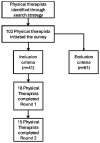Serial casting for contractures in SMA: consensus derived guidelines for treatment
- PMID: 40308222
- PMCID: PMC12040694
- DOI: 10.3389/fneur.2025.1502495
Serial casting for contractures in SMA: consensus derived guidelines for treatment
Erratum in
-
Correction: Serial casting for contractures in SMA: consensus derived guidelines for treatment.Front Neurol. 2025 Jul 16;16:1646078. doi: 10.3389/fneur.2025.1646078. eCollection 2025. Front Neurol. 2025. PMID: 40740843 Free PMC article.
Abstract
Background: Individuals with Spinal Muscular Atrophy (SMA) often present with muscle contractures. Serial casting has been used in a variety of other peripheral nerve, muscle, and central nervous system disorders to improve knee and ankle range of motion limitations and functional performance in both ambulatory and non-ambulatory individuals.
Objective: The goal of this study was to reach a consensus about the parameters, considerations and general guidelines that should inform practice when serial casting to improve flexibility in individuals with SMA.
Methods: This international effort was conducted between August 2020 and May 2023. An expert panel of physical therapists was assembled with multiple panel meetings and a 2-round Delphi survey performed covering topics relevant to serial casting which included three domains: clinical appropriateness, program-based considerations and program adherence/feasibility. Consensus was reached for all items in the three topic areas using a validity index of >75%. Following completion of the Delphi survey, community insights from patients and caregivers were collected via semi-structured interview.
Results: This study included the synthesis of meetings from the initial expert panel which produced a comprehensive survey for the different considerations when performing serial casting for an individual with SMA. The study also included the completion of a Delphi survey by 18 therapists in round 1 and 15 therapists in round 2 for a consensus on 296 items. Strong consensus was obtained in all three domains with 96.6% agreement for clinical appropriateness, 95.0% agreement for program-based considerations, and 96.9% for program adherence/feasibility. A guideline document was developed enumerating the specific items detailed in the survey. Community perspectives were utilized to support the results of the Delphi survey and to add insight into real-world experience.
Conclusion: The serial casting guidelines developed upon collaborative discussions from the expert panel and from the Delphi survey consensus and semi-structured interviews, should be utilized when applying serial casts to patients with spinal muscular atrophy. Future endeavors should look to apply the guideline recommendations to determine casting efficacy for improving joint contracture and impact on function for those with SMA.
Keywords: Delphi technique; consensus; contracture; serial casting; spinal muscular atrophy.
Copyright © 2025 Brown, Hoffman, Corbo-Galli, Kelley, Carry, Civitello, Coratti, DeSanctis, Duong, Driscoll, Flickinger, Glanzman, Jones, Maczek, Moat, Montes, Muni-Lofra, Nelson, Pasternak, Valle and Krosschell.
Conflict of interest statement
The authors declare that the research was conducted in the absence of any commercial or financial relationships that could be construed as a potential conflict of interest.
Figures
References
-
- Berciano MT, Castillo-Iglesias MS, Val-Bernal JF, Lafarga V, Rodriguez-Rey JC, Lafarga M, et al. Mislocalization of SMN from the I-band and M-band in human skeletal myofibers in spinal muscular atrophy associates with primary structural alterations of the sarcomere. Cell Tissue Res. (2020) 381:461–78. doi: 10.1007/s00441-020-03236-3, PMID: - DOI - PubMed
Grants and funding
LinkOut - more resources
Full Text Sources



